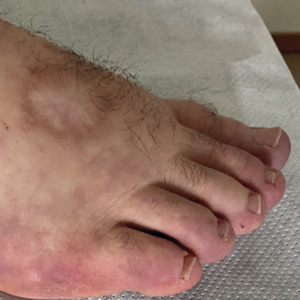Vasculitis associated with adenosine deaminase 2 deficiency: at the crossroads between Behçet’s disease and autoinflammation. A viewpoint

Submitted: 21 March 2023
Accepted: 28 June 2023
Published: 18 September 2023
Accepted: 28 June 2023
Abstract Views: 1300
PDF: 546
Publisher's note
All claims expressed in this article are solely those of the authors and do not necessarily represent those of their affiliated organizations, or those of the publisher, the editors and the reviewers. Any product that may be evaluated in this article or claim that may be made by its manufacturer is not guaranteed or endorsed by the publisher.
All claims expressed in this article are solely those of the authors and do not necessarily represent those of their affiliated organizations, or those of the publisher, the editors and the reviewers. Any product that may be evaluated in this article or claim that may be made by its manufacturer is not guaranteed or endorsed by the publisher.
Similar Articles
- D. Buskila, J. Ablin, Pediatric fibromyalgia , Reumatismo: Vol. 64 No. 4 (2012)
- F. Masini, K. Gjeloshi, E. Pinotti, R. Ferrara, C. Romano, G. Cuomo, Polymyositis following varicella and mumps infection in adults: report of two cases , Reumatismo: Vol. 75 No. 4 (2023)
- P. Frallonardo, R. Ramonda, F. Salaffi, M. Carotti, M. Andretta, P. Zucchetta, A. Dorigo, C. Campana, C. Contessa, A. Iagnocco, G. Valesini, R. Gerli, W. Grassi, L. Punzi, Sjögren’s syndrome: comparison among the main imaging techniques in the study of major salivary glands , Reumatismo: Vol. 60 No. 2 (2008)
- M. Skoczynska, F. Figus, V. Arena, G. Massazza, A. Iagnocco, The role of PET in a clinically silent and ultrasound negative synovitis in the course of rheumatoid arthritis - a case report , Reumatismo: Vol. 73 No. 1 (2021)
- A. Ciocci, L. Buratti, G. Coari, M. Di Franco, A.M. Iagnocco, M.T. Mauceri, A. Serio, Rheumatoid arthritis: frequency of hospitalization and evaluation of economic burden , Reumatismo: Vol. 53 No. 3 (2001)
- M. Vadacca, F. Buzzulini, A. Rigon, G. Coppolino, A. Palma Modoni, R. Massa, A. Afeltra, Neuropsychiatric Lupus Erythematosus , Reumatismo: Vol. 58 No. 3 (2006)
- M. Frassi, A. Brucato, I. Cavazzana, F. Franceschini, D. Faden, M. Motta, A. Doria, R. Cimaz, M.P. Pisoni, M. Muscarà, G. Castellino, G. Brambilla, P.L. Meroni, R. Cattaneo, C. Biasini Rebaioli, C. Antonioli, G. Balestrieri, A. Tincani, Neonatal lupus: clinical features and risk of congenital cardiac heart block in newborns from mothers with anti Ro/SSA antibodies , Reumatismo: Vol. 53 No. 4 (2001)
- A. Cossu, P.A. Cossu, A. Carcassi, Chronic polyarthritis in a patient affected by sarcoidosis and chronic HCV infection. Case report and review of the literature , Reumatismo: Vol. 54 No. 2 (2002)
- A. Iagnocco, C. Perella, F. Ceccarelli, E. Tripodo, C. Alessandri, L. Magrini, G. Valesini, Ultrasonographic assessment of the response to Etanercept treatment in patients with rheumatoid arthritis , Reumatismo: Vol. 58 No. 3 (2006)
- S. Olivieri, A. Ruffatti, A. Bontadi, A. Cavazzana, E. Salvan, S. Cuffaro, S. Giunco, L. Punzi, Clinical value of antibodies to lysobisphosphatidic acid in patients with primary antiphospholipid sindrome , Reumatismo: Vol. 62 No. 2 (2010)
<< < 40 41 42 43 44 45 46 47 48 49 > >>
You may also start an advanced similarity search for this article.

 https://doi.org/10.4081/reumatismo.2023.1578
https://doi.org/10.4081/reumatismo.2023.1578





